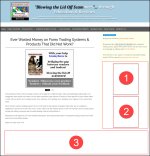MACD reducing False Signals
by Himanshu Jain
(Tokyo)
One of the most commonly used indicator for technical analysis is Moving Average Convergence Divergence or MACD in short. Whether it is Forex trading or stocks or any other commodities, many traders use MACD for their analysis. But then every technical indicator has its limitations and MACD is not an exception.
MACD is lagging indicator and one of the most common trading signal is generated by the crossover of MACD line and signal line. Being a lagging indicator the signals get generated some time after the price has topped up or bottomed down i.e. with a time lag. This lagging cause some false signals, especially when the trend is slow or the market is running sideways.
The main issues faced in weaker trend or in sideways markets are as follows:
1) Signal for trade entry: By the time the entry signal is generated, the price may be reaching the reversal.
2) Exit point or taking profit: By the time the crossover takes place for closing the trade, the price already reverses so much that the profits realized are much less than what it otherwise could be if we would have closed our position earlier.
There is always an ongoing effort to improve the technical analysis by either inventing new indicators or improving the existing indicators either by enhancing the logic or experimenting with the period settings. As an effort to overcome the above mentioned issues and to reduce the number of false signals, Albin, Gunter and Kain came up with some refinements in the original MACD indicator. The first refinement came as MACD R1. There were further refinements in MACD R1 and the subsequent refined version is known as MACD R2.
Though the common trading platforms come fitted with our normal and commonly used moving average convergence divergence indicator. but let's have a look as to what MACD-R1 and MACD-R2 are.
Moving average convergence divergence- Refinement 1 (MACD-R1):
a) To wait for three periods (days on daily chart) after the crossover to take a position. If during that period another crossover takes place then forget the first crossover and wait for another 3 periods.
b) To avoid the exit problem as mentioned in point number 2 above it pre-decides the profit taking levels. What it means that close the trade after 3% or 5% gain after the entry. In case the crossover happens before this pre-decided target of 3% or 55 then also close the position.
Weaknesses of MACD-R1:
1) Still higher number of false signals.
2) Suppose that it is a strong uptrend and after taking a buy position the prices move up by 9%. And what we did that we closed the position after 3% or 5% profit and lost the opportunity of making a bigger profit. So we had a big loss in the profit.
Moving average convergence divergence- Refinement 2 (MACD-R2):
MACD-R2 came into picture to overcome the above mentioned weakness of first refinement of MACD i.e. MACD-R1 i.e. to further reduce the number of false signals.
Let’s think why MACD-R1 still generates higher than desired percentage of false signals:
We wait for 3 periods and as no crossover takes place during these 3 periods, we enter a trade. But then what happens that as soon as we took a position, a reversal in the market takes place and another crossover takes place and we end up making a loss. Well the signal proves to be a false signal.
Reasons behind this kind of possibilities:
It happens because though by the end of the 3 periods after the original crossover, another crossover does not take place but the difference between the MACD and signal line reduces too much. We ignore this reducing difference between MACD and the signal line even though it indicates that another crossover may take place soon and our position may end up wrong.
What additional refinement comes in MACD-R2 to take care of the above issue:
One more condition is put into MACD-R2 apart from the original concepts of MACD-R1. The additional condition for taking the position is to ensure that a pre-decided difference is there between MACD and MACD signal or trigger line even after waiting for 3 periods. Taking into account this difference ensures that another crossover which can make our trade a failure does not take place soon.
Hence suppose we decide that the minimum difference between MACD and signal line should be 1.2% at the end of 3 periods i.e. if the difference is less than 1.2% then we will not enter a trade position. So we see the following for this third condition:
Consider that we are talking about daily chart i.e. one period means one day.
1) Suppose MACD and MACD signal line crossover takes place on July 1st.
2) We wait for 3 days and see that no further crossover has taken place during this time i.e. till July 4th.
3) We check the price. Let's say it is 150.00
4) We check MACD (12 day EMA - 26 days EMA). Let’s say it is 5.
5) We check the signal line (previous 9 days EMA of MACD). let’s say it is 3.
6) We use the formula (MACD-Signal line after 3 periods)*100/(price)
i.e. (5-3)*100/150 = 1.33%
now 1.33% is bigger than the pre-decided minimum difference i.e. 1.2%. This indicates that we can enter a trade as a reversal crossover is not indicated soon.
In case this difference was less than 1.2% then we would have ignored the trade signal.
Quick note about MACD:
MACD= shorter term moving average - longer term moving average.
And MACD signal line is the EMA of the MACD line itself
If we are talking about MACD(26, 12, 9) that means
MACD = EMA for 12 periods - EMA of 26 periods.
The Signal line is derived by taking the Exponential Moving Average of the MACD line. Here with MACD (26,12, 9) we are taking the EMA of MACD for pervious 9 periods.
You may also check other moving averages">forex technical analysis indicators at ForexAbode.
Return to Forex trader Himanshu.





